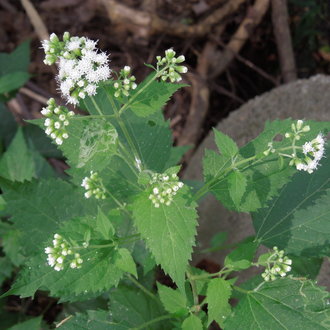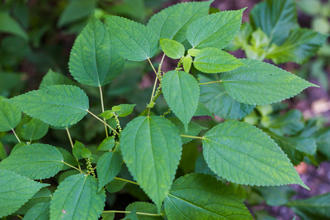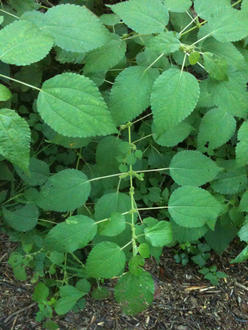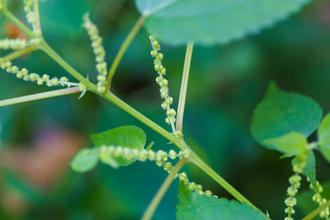Smallspike False Nettle (Boehmeria cylindrica (L.) Sw.)
↑Summary
A perennial nettle-family plant without stinging hairs, found in sunny wetlands and on lightly shaded moist ground.
↑Range - Expand
| Legend | Color |
| Native | |
| Introduced | |
| Native or Not Present | |
| Introduced or Not Present | |
| Native or Introduced or Not Present |
This map is based on our research. We have checked its accuracy to Level 3 ecoregions. Although this plant occurs somewhere in each of these regions, it may only occur in a small part of some or all of them.
↑Similar Plants
↑Habitat
Found in sunny wetlands, especially around the slightly drier margins, as well as on moist ground in sunny openings and edges of deciduous woodlands, especially in floodplains and bottomlands. Moisture requirements are higher in sunnier conditions.
Found both in intact natural areas and anthropogenic habitats; humans probably increase the habitat for this species by creating paths and roads through forests, which create the higher-light conditions it needs.
↑Life Cycle
Seeds germinate in spring, following a period of cold dormancy. In suitable conditions, seedlings can blanket large areas, but mortality is high. This species' successful reproduction and establishment to maturity is dependent on weather conditions, and can also be influenced by disturbance.
Once established, plants are slightly more tolerant of drought and competition from surrounding vegetation. Plants usually reach their maximum size in their second or third year, but can live many years in favorable conditions.
Plants bloom mid-summer to early fall, and flowers are wind-pollinated, with seeds ripening later in fall. Seeds loosen over time, but some remain on the plant well into winter.
↑Faunal Associations
This plant supports insect species that feed on nettle family plants, including the larvae of the red admiral, question mark, and comma butterflies. In some regions this species is among the preferred or most common hosts of the red admiral.
This plant is an occasional, but not preferred browse by mammals such as deer and rabbits. These animals will usually eat only small amounts of this plant.
↑Uses
Infrequently used in gardening, usually in more naturalized plantings, where it is valued for its supporting several species of butterfly in their larval form, yet while lacking the stinging hairs that many of these species' hosts possess.
In Central America, this species has been used as a fiber plant; plants in North America are likely less suited to this use as their stems are less persistent and thus less fibrous.
↑Related Plants
This is the only Boehmeria in most of its range, but in the southeast and along the gulf coast, chinese grass (Boehmeria nivea) has become established in numerous different locations. The broader Boehmerieae tribe also includes graceful pouzolzsbush (Pouzolzia zeylanica), which is established primarily in Florida.
There are numerous plants, both native and introduced, in the yet broader Urticaceae or nettle family.
↑Notes
This species has a wide native range, extending through Central America well into South America. Although in most of North America it is an herbaceous perennial, in the tropical part of its range it can form a woody stem that can persist for multiple years.
↑Links & External Resources
• Boehmeria cylindrica (False Nettle) | Illinois Wildflowers (About This Site)
• Boehmeria cylindrica (Smallspike False Nettle) | USDA PLANTS Database (About This Site)
• Boehmeria cylindrica | Go Botany (About This Site)
• Boehmeria cylindrica | Biota of North America Project (BONAP) (About This Site)
• Boehmeria cylindrica | NatureServe Explorer (About This Site)
• Boehmeria cylindrica | Flora of North America (About This Site)
• Boehmeria cylindrica | Missouri Plants (About This Site)
• Small-spiked False Nettle | Maryland Biodiversity Project (About This Site)
• Boehmeria cylindrica (Small-spike False Nettle) | Minnesota Wildflowers (About This Site)
• Boehmeria cylindrica (L.) Sw. (False Nettle) | Digital Atlas of the Virginia Flora (About This Site)









